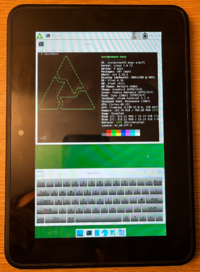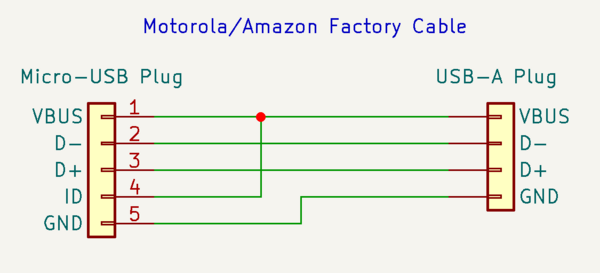Amazon Kindle Fire HD (amazon-tate)
 Kindle Fire HD running XFCE desktop | |
| Manufacturer | Amazon |
|---|---|
| Name | Kindle Fire HD 7" (2nd Gen) |
| Codename | amazon-tate |
| Released | 2012 |
| Type | tablet |
| Hardware | |
| Chipset | TI OMAP 4460 HS |
| CPU | Dual-core 1.2 GHz Cortex-A9 |
| GPU | PowerVR SGX540 |
| Display | 800 x 1280 IPS LCD |
| Storage | 16/32 GB |
| Memory | 1 GB |
| Architecture | armv7 |
| Software | |
Original software The software and version the device was shipped with. |
Android 4.0 |
Extended version The most recent supported version from the manufacturer. |
Android |
| postmarketOS | |
| Category | testing |
Mainline Instead of a Linux kernel fork, it is possible to run (Close to) Mainline. |
yes |
| Device package |
|
| Kernel package |
|
Flashing Whether it is possible to flash the device with pmbootstrap flasher. |
Works
|
|---|---|
USB Networking After connecting the device with USB to your PC, you can connect to it via telnet (initramfs) or SSH (booted system). |
Works
|
Battery Whether charging and battery level reporting work. |
Works
|
Screen Whether the display works; ideally with sleep mode and brightness control. |
Works
|
Touchscreen |
Works
|
| Multimedia | |
3D Acceleration |
Broken
|
Audio Audio playback, microphone, headset and buttons. |
Broken
|
Camera |
Untested
|
| Connectivity | |
WiFi |
Broken
|
Bluetooth |
Untested
|
| Miscellaneous | |
FDE Full disk encryption and unlocking with unl0kr. |
Untested
|
| Sensors | |
Accelerometer Handles automatic screen rotation in many interfaces. |
Untested
|
Contributors
- Foldmorepaper
- Stormwoodpecker
Users owning this device
- Foldmorepaper (Notes: 16GB)
- H ro (Notes: 16GB, bootloader-bricked)
- Little-miss-synth
- Lxpanel (Notes: running android)
- Pixelo789 (Notes: Running stock Fire OS 7.5.1)
- Rainbyte (Notes: OS: Android)
- Stormwoodpecker
- UltrasonicMadness (Notes: 16 GB)
Change Mine to Bricked. -retrocountry
Custom Recovery: TWRP
This custom recovery can only be installed from fastboot, as the bootloader has no exploit. To enter fastboot mode, a fastboot cable (A.K.A. "Fire factory cable", "Motorola factory cable") is needed.
Powering up the device with this cable connected will show an orange 'fastboot' logo shortly after the normal 'Kindle Fire' logo.
TODO:
- walkthrough of directions from the CyanogenMod guide [1]
Cyanogen will install a second, unlocked copy of u-boot to enable custom recovery and unsigned boot images. postmarketOS also relies on the second stage bootloader being present to boot currently.
Installation
Currently, only a console installation of pmOS can be installed. This is due to the bootloader being unable to install images exceeding ~900MB, with sparse images also being unreliable to install. A desktop environment can be installed by installing the console image first, and installing a DE on the installed image.
Initial install
- Run
pmbootstrap init, selecting the following parameters (all unspecified parameters may be left as default):- Channel: edge
- Vendor: amazon
- Device: tate
- User interface: console
- Run
pmbootstrap install. - Ensure the device is powered off, then connect the fastboot cable.
- The device will power up and display an orange fastboot logo.
- Run
pmbootstrap flasher flash_kernel. - Run
pmbootstrap flasher flash_rootfs. - Detach the fastboot cable, then power off the device by holding the power button until the screen blanks.
- Power on the device. After the orange/blue 'Kindle Fire' splash screens, the postmarketOS load screen should appear.
- The initial startup will likely take a while, this is normal.
- Wait for the load animation to stop, then connect a regular micro-USB cable to the device.
- A new network device should appear on the host PC. Connect to the device with SSH (
ssh <username>@172.16.42.1).- If a remote shell opens, pmOS has been successfully installed on the device.
Installing XFCE
XFCE is recommended due to the current lack of graphics acceleration on tate.
- Install a reverse proxy to the Alpine/postmarketOS repo on the host PC following this guide.
- Make sure to also configure the repositories on the device!
- Run
apk updatefollowed byapk add postmarketos-ui-xfce4 xfce4-whiskermenu-plugin postmarketos-artwork-wallpapers postmarketos-artwork-icons xfce4-terminal matchbox-keyboardto install the required XFCE packages and an on screen keyboard. - Fix LightDM starting on framebuffer only devices by setting
logind-check-graphical=falseunder the[LightDM]category of/etc/lightdm/lightdm.conf. - Finally, launch LightDM with
sudo rc-service lightdm restart.- After a few moments, the XFCE desktop should appear. It will now also launch automatically on boot.
Additional Info
Partition Layout
Output of parted /dev/block/mmcblk0 print while in TWRP recovery:
Error: Can't have overlapping partitions. Model: MMC MAG2GA (sd/mmc) Disk /dev/block/mmcblk0: 15.6GB Sector size (logical/physical): 512B/512B Partition Table: gpt
| Number | Start | End | Size | File system | Name | Flags |
|---|---|---|---|---|---|---|
| 1 | 131kB | 262kB | 131kB | xloader | ||
| 2 | 262kB | 524kB | 262kB | bootloader | ||
| 3 | 524kB | 590kB | 65.5kB | idme | ||
| 4 | 590kB | 606kB | 16.4kB | crypto | ||
| 5 | 606kB | 608kB | 2048B | misc | ||
| 6 | 1049kB | 11.5MB | 10.5MB | dkernel | ||
| 7 | 11.5MB | 213MB | 201MB | ext4 | dfs | |
| 8 | 213MB | 230MB | 16.8MB | ext4 | efs | |
| 9 | 230MB | 238MB | 8389kB | recovery | ||
| 10 | 238MB | 246MB | 8389kB | boot | ||
| 11 | 246MB | 1175MB | 929MB | ext4 | system | |
| 12 | 1175MB | 1857MB | 682MB | ext4 | cache | |
| 13 | 1857MB | 15.6GB | 13.8GB | ext4 | userdata |
See also
- pmaports!5473 Initial merge request.
